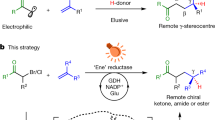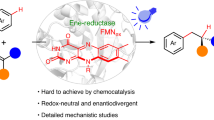Abstract
Enzymes are ideal for use in asymmetric catalysis by the chemical industry, because their chemical compositions can be tailored to a specific substrate and selectivity pattern while providing efficiencies and selectivities that surpass those of classical synthetic methods1. However, enzymes are limited to reactions that are found in nature and, as such, facilitate fewer types of transformation than do other forms of catalysis2. Thus, a longstanding challenge in the field of biologically mediated catalysis has been to develop enzymes with new catalytic functions3. Here we describe a method for achieving catalytic promiscuity that uses the photoexcited state of nicotinamide co-factors (molecules that assist enzyme-mediated catalysis). Under irradiation with visible light, the nicotinamide-dependent enzyme known as ketoreductase can be transformed from a carbonyl reductase into an initiator of radical species and a chiral source of hydrogen atoms. We demonstrate this new reactivity through a highly enantioselective radical dehalogenation of lactones—a challenging transformation for small-molecule catalysts4,5,6,7. Mechanistic experiments support the theory that a radical species acts as an intermediate in this reaction, with NADH and NADPH (the reduced forms of nicotinamide adenine nucleotide and nicotinamide adenine dinucleotide phosphate, respectively) serving as both a photoreductant and the source of hydrogen atoms. To our knowledge, this method represents the first example of photo-induced enzyme promiscuity, and highlights the potential for accessing new reactivity from existing enzymes simply by using the excited states of common biological co-factors. This represents a departure from existing light-driven biocatalytic techniques, which are typically explored in the context of co-factor regeneration8,9.
This is a preview of subscription content, access via your institution
Access options
Subscribe to this journal
Receive 51 print issues and online access
$199.00 per year
only $3.90 per issue
Buy this article
- Purchase on Springer Link
- Instant access to full article PDF
Prices may be subject to local taxes which are calculated during checkout



Similar content being viewed by others
References
Bornscheuer, U. T. et al. Engineering the third wave of biocatalysis. Nature 485, 185–194 (2012)
Bornscheuer, U. T. & Kazlauskas, R. J. in Enzyme Catalysis in Organic Synthesis, Ch. 41 (eds Drauz, K., Gröger, H. & May, O. ) 1695–1723 (Wiley VCH, 2012)
Prier, C. K. & Arnold, F. H. Chemomimetic biocatalysis: exploiting the synthetic potential of cofactor-dependent enzymes to create new catalysts. J. Am. Chem. Soc. 137, 13992–14006 (2015)
Blumenstein, M., Schwarzkopf, K. & Metzger, J. O. Enantioselective hydrogen transfer from a chiral tin hydride to a prochiral carbon-centered radical. Angew. Chem. Int. Edn 36, 235–236 (1997)
Zimmerman, J. & Sibi, M. P. Enantioselective radical reactions. Top. Curr. Chem. 263, 107–162 (2006)
Meggers, E. Asymmetric catalysis activated by visible light. Chem. Commun. (Camb.) 51, 3290–3301 (2015)
Frey, P. A. Radical mechanisms of enzymatic catalysis. Annu. Rev. Biochem. 70, 121–148 (2001)
Maciá-Agulló, J. A., Corma, A. & Garcia, H. Photobiocatalysis: the power of combining photocatalysis and enzymes. Chemistry 21, 10940–10959 (2015)
Park, J. H. et al. Cofactor-free light-driven whole-cell cytochrome P450 catalysis. Angew. Chem. Int. Edn 54, 969–973 (2015)
Conrad, K. S., Manahan, C. C. & Crane, B. R. Photochemistry of flavoprotein light sensors. Nat. Chem. Biol. 10, 801–809 (2014)
Gabruk, M. & Myslia-Kurdziel, B. Light-dependent protochlorophyllide oxidoreductase: phylogeny, regulation, and catalytic properties. Biochemistry 54, 5255–5262 (2015)
Prier, C. K., Rankic, D. R. & MacMillan, D. W. C. Visible light photoredox catalysis with transition metal complexes: applications in organic synthesis. Chem. Rev. 113, 5322–5363 (2013)
Gu, Y., Ellis-Guardiola, K., Srivastava, P. & Lewis, J. C. Preparation, characterization, and oxygenase activity of a photocatalytic artificial enzyme. ChemBioChem 16, 1880–1883 (2015)
Fukuzumi, S., Hironaka, K. & Tanaka, T. Photoreduction of alkyl halides by an NADH model compound. an electron transfer chain mechanism. J. Am. Chem. Soc. 105, 4722–4727 (1983)
Fukuzumi, S., Inada, S. & Suenobu, T. Photoinduced mechanisms of electron-transfer oxidation of NADH analogues and chemiluminescence. Detection of the keto and enol radical cations. J. Am. Chem. Soc. 125, 4808–4816 (2003)
Jung, J., Kim, J., Park, G., You, Y. & Cho, E. J. Selective debromination and α-hydroxylation of α-bromo ketones using Hantzsch esters as photoreductants. Adv. Synth. Catal. 358, 74–80 (2016)
Xu, H.-J., Liu, Y.-C., Fu, Y. & Wu, Y.-D. Catalytic hydrogenation of α,β-epoxy ketones to form β-hydroxyketones mediated by an NADH coenzyme model. Org. Lett. 8, 3449–3451 (2006)
Zhu, X.-Q. et al. Determination of the C4-H bond dissociation energies of NADH models and their radical cations in acetonitrile. Chemistry 9, 871–880 (2003)
Narayanam, J. M. R., Tucker, J. W. & Stephenson, C. R. J. Electron-transfer photoredox catalysis: development of a tin-free reductive dehalogenation reaction. J. Am. Chem. Soc. 131, 8756–8757 (2009)
Maidan, R. & Willner, I. Photochemical and chemical enzyme catalyzed debromination of meso-1,2-dibromostilbene in multiphase systems. J. Am. Chem. Soc. 108, 1080–1082 (1986)
Huisman, G. W., Liang, J. & Krebber, A. Practical chiral alcohol manufacture using ketoreductases. Curr. Opin. Chem. Biol. 14, 1–8 (2009)
Kara, S. et al. Access to lactone building blocks via horse liver alcohol dehydrogenase-catalyzed oxidative lactonization. ACS Catal. 3, 2436–2439 (2013)
Kao, T.-H., Chen, Y., Pai, C.-H., Chang, M.-C. & Wang, A. H.-J. Structure of a NADPH-dependent blue fluorescent protein revealed the unique role of Gly176 on the fluorescence enhancement. J. Struct. Biol. 174, 485–493 (2011)
Hummel, W. Reduction of acetophenone to R(+)-phenylethanol by a new alcohol dehydrogenase from Lactobacillus kefir . Appl. Microbiol. Biotechnol. 34, 15–19 (1990)
Noey, E. L. et al. Origins of stereoselectivity in evolved ketoreductases. Proc. Natl Acad. Sci. USA 112, E7065–E7072 (2015)
Niefind, K., Müller, J., Riebel, B., Hummel, W. & Schomburg, D. The crystal structure of R-specific alcohol dehydrogenase from Lactobacillus brevis suggests the structural basis of its metal dependency. J. Mol. Biol. 327, 317–328 (2003)
Man, H. et al. Structures of alcohol dehydrogenases from Ralstonia and Sphingobium spp. reveal the molecular basis for their recognition of ‘bulky–bulky’ ketones. Top. Catal. 57, 356–365 (2014)
Trott, O. & Olson, A. J. AutoDock Vina: improving the speed and accuracy of docking with a new scoring function, efficient optimization and multithreading. J. Comput. Chem. 31, 455–461 (2010)
Sanli, G., Dudley, J. I. & Blaber, M. Structural biology of the aldo-keto reductase family of enzymes: catalysis and cofactor binding. Cell Biochem. Biophys. 38, 79–101 (2003)
Cuetos, A. et al. Access to enantiopure α-alkyl-β-hydroxy esters through dynamic kinetic resolutions employing purified/overexpressed alcohol dehydrogenases. Adv. Synth. Catal. 354, 1743–1749 (2012)
Acknowledgements
Financial support was provided by Princeton University. D.G.O. also acknowledges financial support from the Natural Sciences and Engineering Research Council of Canada (NSERC). We thank the MacMillan group for use of their chiral high-performance liquid-chromatography and cyclic-voltammetry equipment; G. Scholes for providing the time-resolved fluorescence instrument; H. Yayla of the Knowles group for assistance with cyclic-voltammetry experiments; B. Shields of the Doyle group and the Scholes Group for collection of the LED emission spectrum; and G. Huisman of Codexis for conversations regarding the nature of the mutants in the Codexis KRED kit.
Author information
Authors and Affiliations
Contributions
M.A.E and T.K.H. designed the experiments, performed and analysed experiments, and prepared the manuscript. N.R.G. performed and analysed experiments. D.G.O. collected and analysed time-resolved fluorescence data.
Corresponding author
Ethics declarations
Competing interests
The authors declare no competing financial interests.
Additional information
Reviewer Information
Nature thanks E. Meggers and the other anonymous reviewer(s) for their contribution to the peer review of this work.
Extended data figures and tables
Extended Data Figure 1 Control experiments for degree of elimination product.
a, b, Lactone (1) does not undergo spontaneous dehydrogenation to produce dehydrolactone (3) in solution, either under irradiation (a) or without irradiation (b). This further suggests that the reaction is not proceeding via KRED-catalysed alkene reduction.
Extended Data Figure 2 Control for promiscuous alkene-reductase activity.
Dehydrolactone (3, left) is unreactive under our reaction conditions; thus, product 2 is not formed by KRED-catalysed alkene reduction.
Extended Data Figure 3 Control for the effects of excess nicotinamide.
Product yield and enantiomeric excess remain relatively unchanged over a wide range of NADP loadings. This suggests that, once KRED is fully loaded with NADP, further increases in NADP concentration have little effect; that is, NADP needs to be bound to KRED in order to exert its effect in this reaction.
Extended Data Figure 4 Absorbance spectra.
a, In the presence of KRED, there is a redshift in the absorbance spectrum of NADPH when substrate is added to the system. This shift is potentially indicative of a charge-transfer complex being formed between the substrate and NADPH. These spectra are overlaid with the emission spectrum of the blue LED source used in all experiments. b, In the absence of KRED, no such absorption shift is seen when substrate is added. Together, these data suggest that light (LED) irradiates a charge-transfer complex comprising substrate, NADPH and enzyme to initiate the catalytic cycle.
Extended Data Figure 5 Time-correlated single-photon counting.
The lifetimes of fluorescence-excited states of NADPH, with and without enzyme and substrate, were determined using time-correlated single-photon counting (TCSPC) on a HORIBA Scientific DeltaFlex TCSPC system. Each sample was concentrated to an optical density of approximately 0.1 absorbance units and excited using a 305-nm laser; fluorescence emission decay was then probed at 460 nm. Data analysis was done using HORIBA Scientific DAS6 decay analysis software, whereby each data set was fit to an exponential curve to obtain the lifetimes.
Extended Data Figure 6 Docking models.
Automated docking models were obtained using Autodock Vina28. Panels a and b indicate two different docking poses as predicted by Autodock. Chain C of RasADH (PDB = 4BMS) was used as a receptor and prepared using Autodock tools. Coordinates for all ligands were prepared using Gaussian and Autodock tools. The active site of RasADH was contained in a 10 × 10 × 10 grid with 1 Å spacing, centred around position 45 × 9.431 × 37.226, which approximately corresponds to the C4–H bond of NADPH. The exhaustiveness parameter was set to 10 and the rest of the docking parameters were set to default. Docking models for substrate 2 were accessed for their ability to rationalize the observed stereochemistry and provide a reasonable distance and geometry for hydrogen-atom transfer. The blue ribbon shows chain C of RasADH. Substrate 2 is shown in ball-and-stick format, with oxygens in red, lactone carbons in blue, and aromatic carbons in white. The left and right images are two different views of the same model.
Extended Data Figure 7 Chlorolactone 1′ in dehalogenation.
The halolactone 1′ shows similar reactivity to its bromolactone counterpart (1) under the same reaction conditions.
Supplementary information
Supplementary Information
This file contains Supplementary Methods, Supplementary Text and Data, Supplementary Figures 1-10 and additional references (see Contents for more details). (PDF 19398 kb)
Rights and permissions
About this article
Cite this article
Emmanuel, M., Greenberg, N., Oblinsky, D. et al. Accessing non-natural reactivity by irradiating nicotinamide-dependent enzymes with light. Nature 540, 414–417 (2016). https://doi.org/10.1038/nature20569
Received:
Accepted:
Published:
Issue Date:
DOI: https://doi.org/10.1038/nature20569
This article is cited by
-
Remote stereocontrol with azaarenes via enzymatic hydrogen atom transfer
Nature Chemistry (2024)
-
A light-driven enzymatic enantioselective radical acylation
Nature (2024)
-
Enzyme-controlled stereoselective radical cyclization to arenes enabled by metalloredox biocatalysis
Nature Catalysis (2023)
-
Tailored photoenzymatic systems for selective reduction of aliphatic and aromatic nitro compounds fueled by light
Nature Communications (2023)
-
Biocatalytic characterization of an alcohol dehydrogenase variant deduced from Lactobacillus kefir in asymmetric hydrogen transfer
Communications Chemistry (2023)
Comments
By submitting a comment you agree to abide by our Terms and Community Guidelines. If you find something abusive or that does not comply with our terms or guidelines please flag it as inappropriate.



